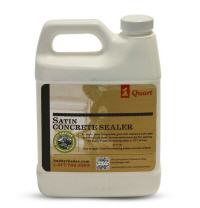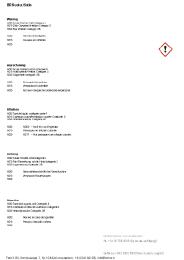Satin Sealer /1 lt
Buddy Rhodes Satin Sealer is a water based acrylic micro emulsion technology for concrete countertops. It creates a barrier coating that seals and protects while enhancing the natural beauty of the concrete. The sealer will resist most stains up to 72 hours, however, oils and solvents should be wiped up promptly. It provides the main source of protection in the Buddy Rhodes Sealing System, especially againstacids. Coverage is approximately 4.65 m2 per 1 lt.
- Read the safety information label. Click on the image
- Lea la etiqueta de información de seguridad. Haga clic en la imagen
- Lesen Sie das Sicherheitsinformationsetikett. Klicken Sie auf das Bild.
- Lisez les informations de sécurité cliquez sur l'image
- Lees het veiligheidsinformatie label. Klik op de afbeelding.
|
|
Application Guide
Concrete Surface Preparation
Preparing the concrete surface before sealing is an important first step to ensure success with any sealer. The concrete must meet three conditions before starting with the sealer application:
• It should be properly cured.
• It should be properly processed.
• It should be clean and dry.
Curing
Standard practice is to allow the concrete to cure for 5-7 days after casting, adhering to good concrete curing practices. This ensures the cement matrixis maturing and the internal moisture levels have been reduced to low levels.For some concrete mixes this happens in a few days, for others it will take longer. You will need to set the time between casting and sealing based on the habits of the concrete you are working with. With Buddy Rhodes mixes, 5 days following casting is a good start, although more time should be given during cooler periods, and more time isalways better if you have time to give. For best results, let your concrete cure for at least 7 days.
Processing
The surface of the bare concrete should be processed to a visually matte finish, with a profile, or "tooth,"prior to sealing. This ensures the sealer develops a good mechanical bond with the surface. The rougher the
surface is, the better the sealer will adhere. Profiling also removes residual material or contaminants that wouldinterfere with forming a good bond. Wax and form release agents routinely transfer to the surface of the
concrete during casting, and these must be removed before sealing.
There are several ways to profile concrete surfaces. Acid Etching, Wet Sanding and Dry Sanding are three goodoptions, described below.
• Acid Etching- Acid etching provides a "tooth" for the sealer and dissolves any weak material in the substrate that may prohibit sealer from fully penetrating and adhering. Etching is most often performed on cream
finishes, or concrete that’s left untouched after it is demolded. Keep in mind acid etching mainly affectsthe cement paste, and will not change the surface of exposed glass, tile, or exposed stone such as quartz or granite. Etching may not entirely remove surface residue like wax or form release agents. For that werecommend light scrubbing with a non-woven abrasive pad. Muriatic acid substitutes are not recommendedas these types of acids can cause inconsistent reactions with the sealer. After acid etching, rinse well withclean water to remove any acid residue.
• Wet Polishing or Sanding - A popular and easy way to lightly work the surface without exposing sand grains is to hand-sand the surface using Buddy Rhodes hand pads. Use a 400-grit hand pad, as coarser grit can
leave scratches and can be too aggressive. The hand pads should always be used wet to prevent scratchingthe concrete surface. They're a great way to remove surface residue and to lightly smooth the concrete’s
surface. A wet-sanded surface can be etched to further enhance the microscopic tooth. When polishing alarger area or to remove material faster and efficiently, a pneumatic or electric polisher could be used.
• Dry Sanding- A method of opening the surface of the concrete or smoothing the surface of the concretewith processing methods that do not depend on the use of water. These methods include using the BR hand
pads dry, or using mechanical equipment such as orbital sanders or rotary polishers with dry diamonds pads.All tooling should be attached to vacuum equipment to control any dust that may occur during the surface
processing
Cleaning & Drying
The concrete surface should be cleaned after it has been profiled, since etching or sanding concrete creates very fine residue that must be removed before sealing. Non-woven abrasive pads can be used to remove the
fine residue. Rinse well with clean water. After cleaning, allow the concrete to fully dry prior to applying sealer. Dry concrete lets the sealer penetrate into the concrete, whereas wet, damp or barely dry concrete does not. A good rule of thumb is to wait a minimum of 12 hours for the concrete to dry following total saturation. Cooler shop temperatures will slow evaporation, so if the temperature is below 70°F/21°C, give the concrete more
time to dry out. When in doubt, wait 24 hours.
Environment
The Buddy Rhodes Sealing System should be applied at normal room temperature and humidity, and care should be taken to minimize airborne dust. Air and surface temperature should be between 10°C and 26.7°C
for 24 hours following application.
Tools and Materials Required for Sealer Application
• Microfiber Sponges
• Foam Rollers
• Microfiber Cloths
Application of Penetrating Sealer
The Buddy Rhodes Penetrating Sealer can be applied with microfiber cloths or sponges, or with a foam roller. Applya single, uniform coat and allow to dry completely before moving on to the next step, which usually takes about anhour depending on conditions. Do not apply in direct sunlight when temperature exceeds 26.7°C. Cleanup when wet with fresh water.
Application of Satin Sealer
The Buddy Rhodes Satin Sealer is applied using microfiber cloths, sponges, or a foam roller. Apply several thin, form layers, allowing material to dry between each coat, which usually takes an hour depending on conditions.Test each layer by sprinkling a small amount of water on the sealed surface. If water penetration occurs or if water does not bead up on the surface, apply an additional layer. This test should be performed after each coat. Do not apply in direct sunlight when temperature exceeds 27°C. Cleanup when wet with fresh water. If dried, use lacquer thinner or xylene.
Application of Beeswax
Apply with a soft microfiber cloth or sponge. Buff with a soft cloth or mechanical buffer to an even sheen.
Care and Maintenance
• Wipe up spills as they occur.
• Clean regularly with recommended non-abrasive cleaners such as Clorox Kitchen Cleaner or Windex Vinegar MultiSurface Cleaner
• Soft abrasive cleaning sponges can be used such as Scotch-Brite Non-Scratch Scrub Sponges
• Never used a sealed countertop as a cutting board.
• Always use coasters or felt pads below anything with sharp edges.
• Avoid leaving potted plants or objects that will maintain wet contact in one spot with the counters for extended
periods of time.
• Reapply beeswax once per month or as necessary to maintain protection and appearance.

